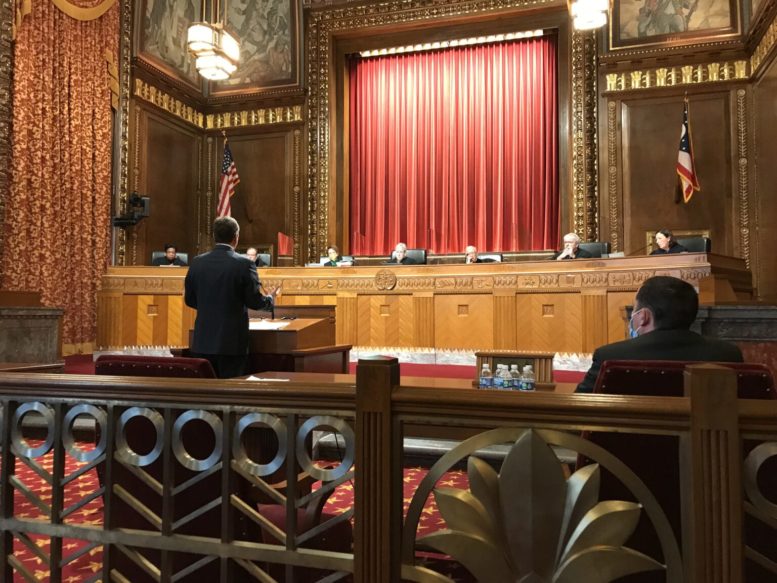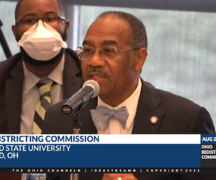BY SUSAN TEBBEN
Three groups challenging district maps for the Ohio House and the Ohio Senate made their cases Wednesday that the Ohio Supreme Court should reject maps approved by state Republican leaders.
The League of Women Voters, The Ohio Organizing Collaborative and a group of a dozen Ohio residents pushed the state’s highest court to find that the Ohio Redistricting Commission had violated the constitution, especially a provision they say prohibits partisan gerrymandering in the state, when it passed maps 5-2 along party lines.
The League points to Article 11 of the Ohio Constitution — the article that holds the requirements and rules for redistricting — and specifically section six, which says the commission should look at state and federal partisan elections over the past 10 years to identify the political party that historically won districts in the state.
The section is also the part of the constitution that prohibits map-drawers from unfairly favoring or disfavoring a particular political party.
“Here, the commission isn’t choosing between a rock and a hard place,” said attorney Freda Levenson, of the ACLU, representing the League of Women Voters. “Now, we have a commission saying we don’t think we have to comply with this provision of the constitution.”
According to court documents, a LWV expert witness said Republicans received 54.5% of the two-party vote in Ohio, with Democrats receiving 45.5% over the past 10 years of elections in the state. This is the map ratio anti-gerrymandering groups argued for in days of hearings with the ORC before the maps were approved.
In the plan approved in September, the League argues Republicans receive 67% of House districts and 69% of the Senate.
Republicans, specifically Senate President Matt Huffman and House Speaker Bob Cupp, have called section six of the constitutional requirements “aspirational” because of language in the constitution that says redistricting leaders “shall attempt” to draw districts that don’t favor or disfavor a political party.
Attorney Phillip Strach, who represented Huffman and Cupp in arguments before the supreme court, framed the section as a “carrot and stick” method of incentivizing bipartisan teamwork.
“If they can cut a deal, they can cut a deal; they’ve got a ten-year map, that’s one of the carrots,” Strach told the court.
Strach also claimed section six is only meant to come into play if there is a violation of anti-gerrymandering rules in the rest of the redistricting process.
“There’s been no allegations, certainly no proof, that any of those anti-gerrymandering requirements were violated,” Strach said. “None.”
Levenson argued that all the constitutional provisions are required and not dependent upon one another, however, even if the GOP sees a section as “aspirational,” that doesn’t preclude them from making an effort to comply.
“You need an excuse for not meeting them, and that’s why you need an attempt,” Levenson said.
The question of minority representation within the state didn’t go unmentioned during oral arguments. Attorney Brian Sutherland represented the Ohio Organizing Collaborative on the topic, and said the plan infringes on fundamental rights without justification and treats certain voters differently, in violation of the constitution.
Sutherland said because of packing and cracking — the compressing of minority votes into the fewest number of districts or the dilution of votes through too many districts — certain groups “won’t have the equal opportunity to obtain representation at the general assembly level.”
“The harm from packing is evident; it should have been apparent from drawing this map,” Sutherland said.
Supreme court justices questioned Strach on comments made by redistricting commission members such as Gov. Mike DeWine and Secretary of State Frank LaRose, who expressed in media reports and in court documents their disappointment with the process.
“I know the evidence shows (LaRose) was involved with a lot of meetings, he had a lot of conversations, and at the end of the day, Secretary of State LaRose voted for the plan and he testified that he believes it’s constitutional,” Strach said.
Pushing further on the topic, Justice Michael Donnelly asked Strach if the record demonstrated that LaRose was “extremely frustrated and he only did that just to go along with that partisan vote … as was Gov. DeWine.”
Chief Justice Maureen O’Connor brought up an email sent by LaRose that called the plan “asinine,” and comments by DeWine wishing for “a more constitutional plan,” in O’Connor’s words.
“The legally relevant action here is the vote,” Strach responded. “The vote was the vote, that’s what adopted the plan. What people said about it, we believe, is legally irrelevant.”
Strach said the commission’s duty was “to adopt a plan, that’s an up or down vote.”
Levenson went so far as to say the court can’t presume that redistricting leaders had a focus on constitutionality, because the process defined in the constitution “was not followed.”
“The information was not shared among the commissioners, and the public was not involved in the process to the extent that the new (constitutional requirements) required,” Levenson said.
Democratic members of the ORC are on the side of the map challengers in the case. State Sen. Vernon Sykes, D-Akron, served as co-chair of the redistricting commission, and House Minority Leader Emilia Sykes served as the other minority member of the commission.
Both Sykes say the commission didn’t work toward a common goal, a bipartisan map, and in fact “ignored” bipartisanship rules in the constitution and minority representation possibilities in the legislative maps.
The state supreme court won’t issue its decision for a while, but dialogue during Wednesday’s oral arguments showed they aren’t against rejecting the maps and ordering the ORC to try again.
“Let’s say we disagree with you and this court orders the commission to start over,” O’Connor posed. “Then what happens? They come up with a new map?”
Strach said next steps would depend on the specific ruling, and guidance provided by the court on how to adhere to the constitution. He went on to say section six needed more definition, in terms of how the commission would calculate statewide voter preferences.
“Section six does not define what it means by the statewide preferences,” Strach said. “That could be calculated a hundred different ways.”
Strach said after that guidance is provided, the commission could produce a new map, or “certain parties” could decide to go to the U.S. Supreme Court “and say, this Ohio Supreme Court has now ordered us to violate federal law by gerrymandering in the urban counties, because we can’t gerrymander in rural counties.”
Another possibility is a federal case in which a judge draws the maps if Ohio can’t “get their stuff together,” according to Strach.





